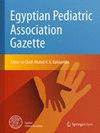Effect of phototherapy on eosinophils count in neonatal hyperbilirubinemia (cross-sectional study)
IF 0.5
Q4 PEDIATRICS
引用次数: 0
Abstract
Abstract Background Neonatal jaundice is a common disorder in neonates. Phototherapy is associated with various side effects despite being safe. This research aimed to determine the impact of phototherapy (PT) on eosinophil levels in neonates treated for unconjugated hyperbilirubinemia. Methods In this cross-sectional prospective study, icteric neonates admitted to the Neonatal Intensive Care Unit (NICU) of Abo-Elreesh Child Hospital, Cairo University, from July 2020 to June 2021 were assessed. Laboratory data, including serum bilirubin and blood cell differentiation for eosinophils before and after phototherapy, were collected, and demographic data like age, gender, gestational age, and duration of phototherapy were taken. Results Two hundred neonates were included in this study. Hyperbilirubinemia was most frequently related to ABO group incompatibility (44.5%). After phototherapy, total serum bilirubin and neutrophil levels were significantly decreased, and platelet levels were significantly increased. Eosinophil count and percent were significantly increased ( p < 0.001) following phototherapy. A statistically significant positive correlation was found between eosinophil count before and after PT ( r = 0.583, p < 0.001) and between eosinophil percent before and after PT ( r = 0.617, p < 0.001). Conclusion Serum eosinophils were increased after phototherapy in icteric neonates with hyperbilirubinemia.光疗对新生儿高胆红素血症嗜酸性粒细胞计数的影响(横断面研究)
背景新生儿黄疸是一种常见的新生儿疾病。光疗虽然安全,但也有各种各样的副作用。本研究旨在确定光疗(PT)对未结合高胆红素血症新生儿嗜酸性粒细胞水平的影响。方法在这项横断面前瞻性研究中,对2020年7月至2021年6月在开罗大学Abo-Elreesh儿童医院新生儿重症监护病房(NICU)住院的黄疸新生儿进行评估。收集光疗前后血清胆红素、嗜酸性粒细胞血细胞分化等实验室数据,采集年龄、性别、胎龄、光疗持续时间等人口统计学数据。结果本研究共纳入200例新生儿。高胆红素血症最常与ABO血型不合相关(44.5%)。光疗后血清总胆红素和中性粒细胞水平明显降低,血小板水平明显升高。嗜酸性粒细胞计数和百分比显著增加(p <0.001)。治疗前后嗜酸性粒细胞计数有统计学意义的正相关(r = 0.583, p <0.001),且PT前后嗜酸性粒细胞百分比差异有统计学意义(r = 0.617, p <0.001)。结论黄疸合并高胆红素血症新生儿光疗后血清嗜酸性粒细胞升高。
本文章由计算机程序翻译,如有差异,请以英文原文为准。
求助全文
约1分钟内获得全文
求助全文
来源期刊

Egyptian Pediatric Association Gazette
PEDIATRICS-
自引率
0.00%
发文量
32
审稿时长
9 weeks
期刊介绍:
The Gazette is the official journal of the Egyptian Pediatric Association. The main purpose of the Gazette is to provide a place for the publication of high-quality papers documenting recent advances and new developments in both pediatrics and pediatric surgery in clinical and experimental settings. An equally important purpose of the Gazette is to publish local and regional issues related to children and child care. The Gazette welcomes original papers, review articles, case reports and short communications as well as short technical reports. Papers submitted to the Gazette are peer-reviewed by a large review board. The Gazette also offers CME quizzes, credits for which can be claimed from either the EPA website or the EPA headquarters. Fields of interest: all aspects of pediatrics, pediatric surgery, child health and child care. The Gazette complies with the Uniform Requirements for Manuscripts submitted to biomedical journals as recommended by the International Committee of Medical Journal Editors (ICMJE).
 求助内容:
求助内容: 应助结果提醒方式:
应助结果提醒方式:


